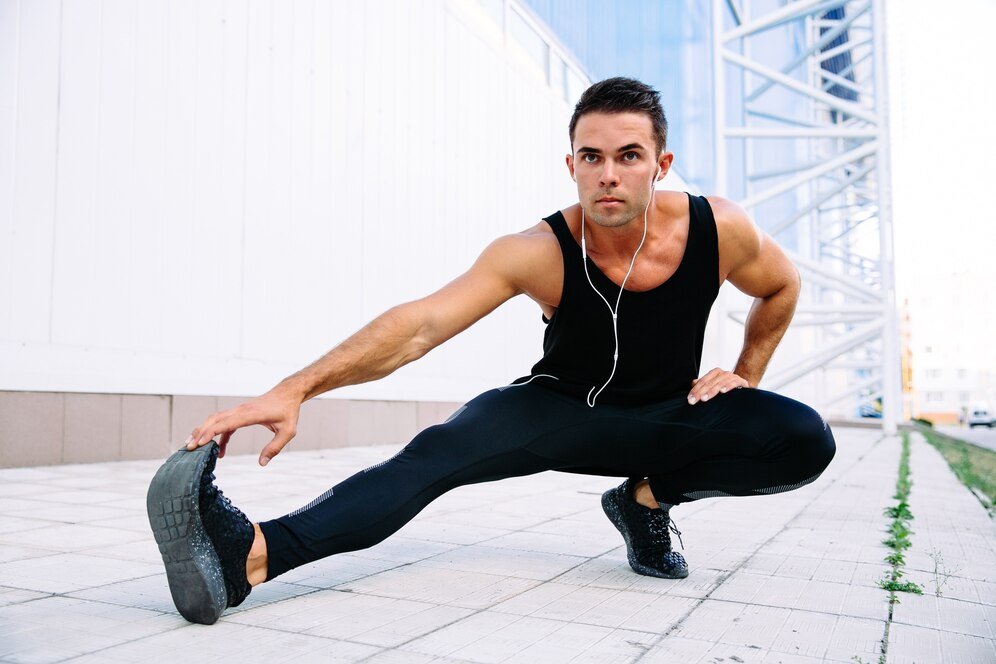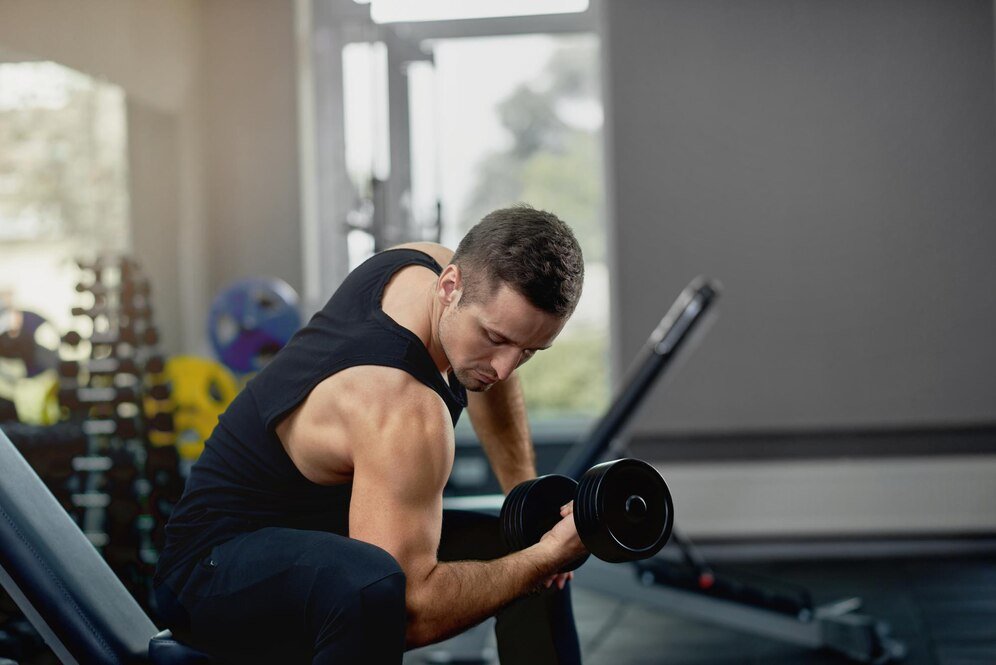Whether you're an athlete looking to boost your performance, a fitness enthusiast seeking to maintain flexibility, or simply someone striving for better overall movement, this blog post is tailored just for you.
Your legs play a pivotal role in your daily activities, from walking and running to bending and squatting.
As such, ensuring optimal mobility in your lower body is essential for maintaining a high quality of life.
In this article, we'll discuss a series of effective leg mobility exercises designed to target different muscle groups, improve joint flexibility, and enhance your range of motion.
So, let's kick-start your journey towards more fluid and unrestricted movement:
Best Mobility Exercises For Legs
Listed below are the best leg mobility workouts that will add explosive strength to your legs:
1. Glute Stretch

The glute stretch is a simple yet effective mobility exercise that offers numerous benefits for the legs and hips.
This motion increases flexibility in the hip and glute areas, providing relief from tension and promoting a better range of motion in the hip joints.
As you hold the stretch, you'll experience a gentle release of stress in the lower back and hips, contributing to improved overall comfort.
Step-By-Step Guide
- Lie down on a comfortable surface, such as a yoga mat or carpet.
- Bend both knees and place your feet flat on the ground, hip-width apart.
- Lift your right foot off the ground and cross your right ankle over your left knee, forming a figure-four shape.
- Gently flex your right foot to protect your knee joint.
- Reach both hands through the space created by your legs and interlace your fingers behind your left thigh.
- As you hold onto your left thigh, gently draw your legs toward your chest, feeling a stretch in your right glute and hip.
- Keep your head and shoulders relaxed on the ground throughout the stretch.
- Breathe deeply and hold the stretch for 20-30 seconds.
- Release the stretch slowly and switch sides, crossing your left ankle over your right knee, and repeat the process.
Mistakes to Avoid
- Avoid pulling too hard, aiming for a gentle and comfortable stretch.
- Do not tense your neck or shoulders; keep them relaxed.
- Ensure your ankle is flexed to protect your knee joint.
2. Prisoner Get-Up
The prisoner get-up is a dynamic leg mobility exercise that encompasses a range of benefits.
As you step back into a lunge position and then rise, you engage various muscle groups in the legs, including the quadriceps, hamstrings, and glutes.
This athletic mobility exercise enhances lower body strength and stability while simultaneously working to improve balance and coordination. The engagement of the core muscles throughout the movement further adds to its effectiveness, contributing to a stronger core and better postural alignment.
Step-By-Step Guide
- Begin standing with your feet shoulder-width apart and your posture upright.
- Place your hands lightly behind your head, fingers interlocked, and elbows pointing out to the sides.
- Take a controlled step back with your right leg, shifting your weight onto the ball of your right foot.
- Lower your body by bending both knees, aiming to create two 90-degree angles with your legs.
- Press firmly through your right heel to stand back up, engaging your right glutes and quadriceps.
- Repeat the same process on the opposite side, stepping back with your left leg.
Mistakes to Avoid
- Do not allow your knees to extend beyond your toes during the lunge.
- Keep your back straight and avoid leaning too far forward or backward.
- Maintain a controlled pace; avoid rushing through the movement.
3. Jump Squat

Jump squats are a high-intensity and strengthening leg mobility workout that brings a plethora of advantages.
By initiating a squat and then explosively jumping into the air, you challenge your leg muscles in a dynamic and powerful way. The primary muscles targeted during jump squats include the quadriceps, hamstrings, and calf muscles.
Beyond building explosive leg power, this exercise elevates your heart rate, improving cardiovascular fitness and aiding in calorie burning.
Step-By-Step Guide
- Stand with your feet slightly wider than shoulder-width apart.
- Initiate the squat by pushing your hips back and bending your knees.
- Lower your body down while keeping your chest lifted and your back straight.
- Explosively push through your feet, jumping upwards.
- As you jump, extend your arms overhead to help propel you upwards.
- Land softly on the balls of your feet, lowering your body back into the squat position.
Mistakes to Avoid
- Avoid letting your knees cave inward during the squat and jump.
- Land softly to reduce the impact on your joints.
- Keep your core muscles engaged throughout the movement.
4. Lateral Lunge

The lateral lunge is a lateral movement exercise that offers a host of benefits for leg mobility and overall lower body function.
This exercise is particularly useful for addressing muscle imbalances between the legs and helping to correct any discrepancies in strength or range of motion.
Additionally, the lateral lunge enhances lateral movement capabilities, which can be valuable for sports and activities that involve side-to-side motions.
By maintaining proper form and practicing controlled lunges, you can unlock improved leg mobility and functional performance.
Step-By-Step Guide
- Begin standing with your feet together and your posture upright.
- Take a wide step to your right side, shifting your body weight onto your right foot.
- Bend your right knee, lowering your body into a lateral lunge, while keeping your left leg straight.
- Push your hips back and lower your body until your right thigh is approximately parallel to the ground.
- Press through your right heel to return to the starting position.
- Repeat the same process on the left side.
Mistakes to Avoid
- Keep your back straight and chest up throughout the movement.
- Ensure your knees track in line with your toes during the lunge.
- Avoid allowing your knee to extend beyond your toes.
5. Kettlebell Offset Squat

The kettlebell offset squat is a unique leg mobility exercise that provides several advantages for your lower body and core.
Holding a kettlebell in one hand while performing squats challenges your stability and engages your core muscles as they work to maintain balance. The exercise targets the quadriceps, hamstrings, and glutes, promoting strength and mobility in these muscle groups.
This exercise is particularly beneficial for addressing muscle imbalances and ensuring symmetrical development between both sides of the body.
Step-By-Step Guide
- Hold a kettlebell in your right hand, letting it hang down by your side.
- Stand with your feet shoulder-width apart, toes pointed slightly outward.
- Keep your left arm extended to the side for balance.
- Initiate the squat by pushing your hips back and bending your knees.
- Lower your body while maintaining a straight back and a neutral spine.
- As you squat down, allow the kettlebell to hang naturally.
- Push through your heels to stand back up, returning to the starting position.
- Repeat the movement, holding the kettlebell in your left hand.
Mistakes to Avoid
- Keep your back straight and chest lifted during the squat.
- Do not allow the kettlebell to pull you to the side; engage your core.
- Ensure your knees are aligned with your toes during the squat.
Final Verdict
Incorporating leg mobility exercises into your regular fitness routine can bring about many benefits that extend far beyond physical performance.
By dedicating time to improve your legs' flexibility and range of motion, you're investing in your overall well-being and longevity.
Remember, enhanced leg mobility empowers you to move with greater ease, reduces the risk of injuries, and alleviates muscle tension.
Whether you're an office worker, an athlete, or anyone in between, these exercises provide a pathway to increased freedom of movement and improved quality of life.



